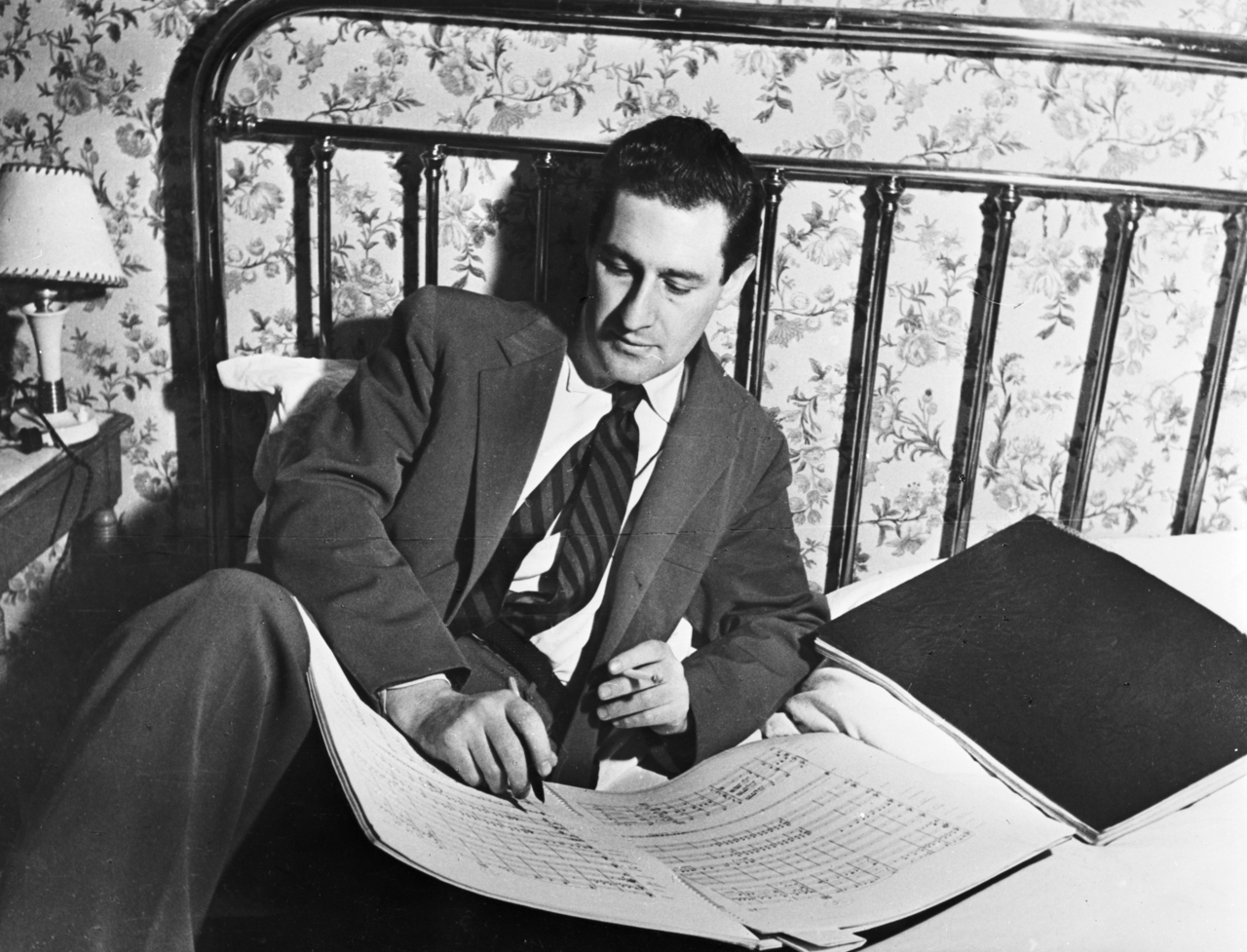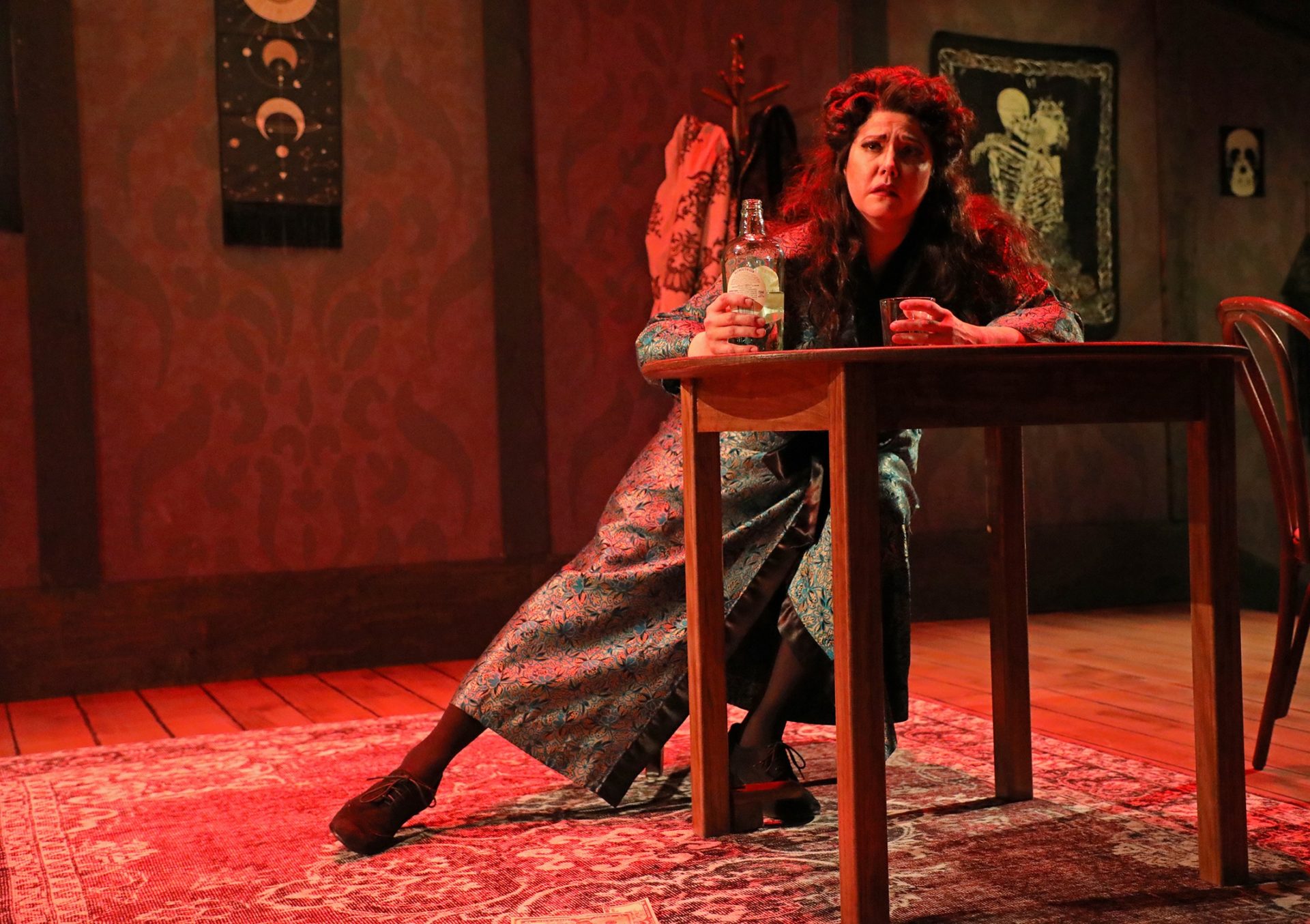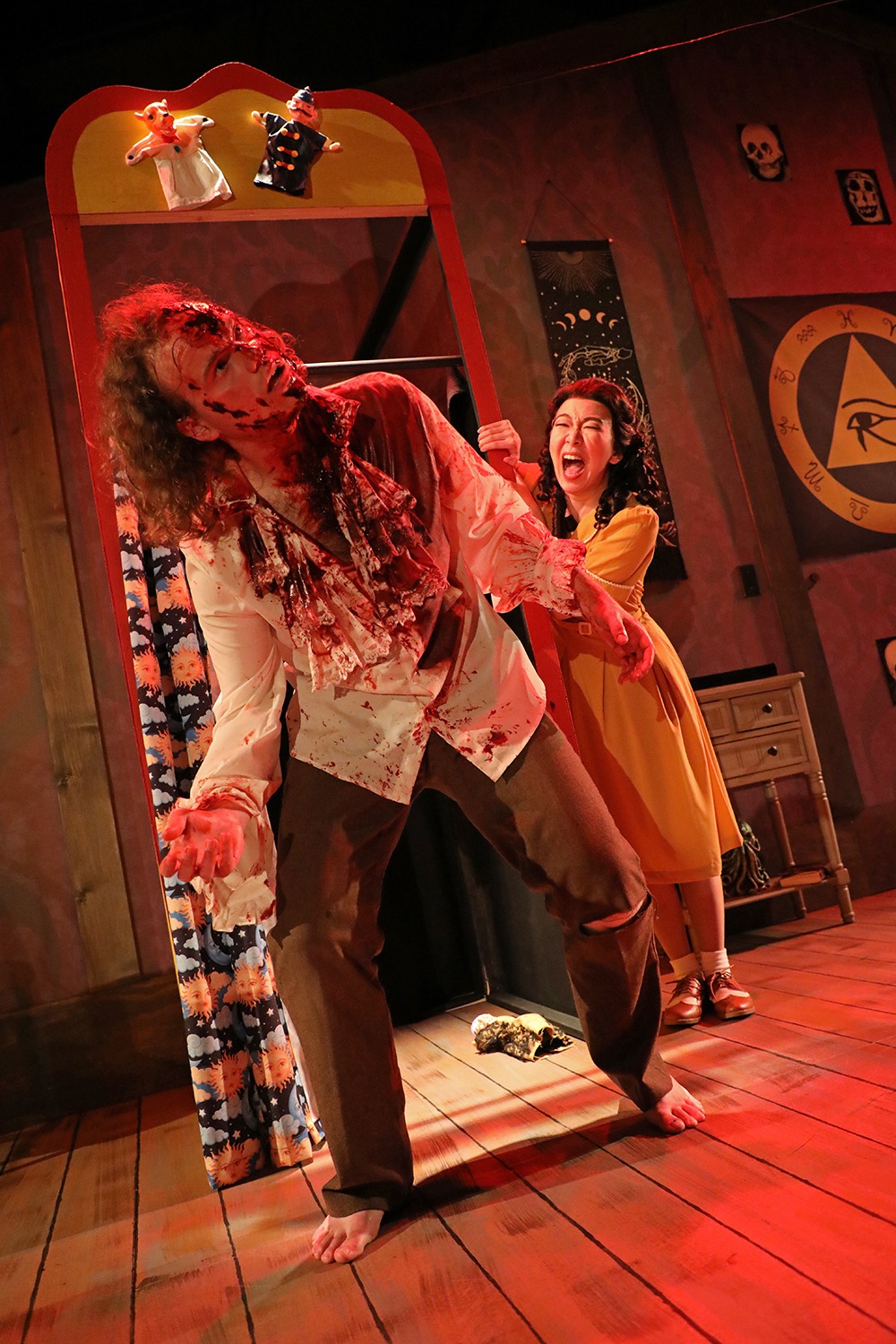Voices Behind the Gauze: Nashville Opera’s The Medium
You really feel the passion when Nashville Opera’s Artistic Director, John Hoomes, pleads the case for the operas of Gian Carlo Menotti. In his program note for the Nashville Opera’s new production of Menotti’s phenomenal and eerie The Medium, Hoomes recounts defending the composer’s honor when challenged by “an earnest, yet self-important, opera snob” at a discussion panel some years ago. Why all the controversy? “He wrote some beautiful, accessible operas that were loved by audiences and found great success,” he explains. “However, in the mid-20th century when most composers were writing more dissonant music, Menotti became somewhat of a persona non grata among serious classical music buffs.” Musicologist and serious classical music buff Joseph Kerman wrote highly critically of Menotti in his polemical 1956 book Opera as Drama. Not only did Kerman call Menotti “trivial” and “a sensationalist in the old style, and in fact a weak one,” elsewhere in the book he compares Strauss’s Salome and Menotti’s The Medium to “drawing-room comedies.”

Though Kerman saw Menotti as “belong[ing] to another era,” it’s hard to say his critiques really had anything to do with the composer’s penchant for tunefulness and tonality. An entire chapter is dedicated to Kerman’s love for Mozart’s operas, after all, which certainly can’t be said to lack either quality. Instead, as the title of the book suggests, Kerman was concerned with the dramatic potential of operatic music, which could theoretically express itself in any style. It seems Kerman saw Menotti’s works primarily as dramatic failures rather than musical ones. For a number of reasons, especially in the case of The Medium, it’s worth coming to Menotti’s defense here too. Not only is his music in turns lovely and unsettling, the drama of Menotti’s The Medium is subtly rich and largely concerned with the nature of opera itself.
The story takes place at the parlor of Madame Flora, a cruel, often drunk woman who performs phony séances. Monica and Toby are her two young servants/children (the exact nature of their background is left eerily vague). They run the show—Toby, who can’t speak, operates the smoke and mirrors while Monica evokes the voices of lost loved ones from behind a gauze screen. Act I lets us in on these characters and their scam. We learn of Madame Flora’s abusive nature and Monica’s love for Toby. Things come to a head when Madame Flora ends the night’s séance suddenly, screaming out that someone’s touched her. Now she hears the voices behind the gauze even when she’s alone. Things turn tragic in Act II as Madame Flora’s guilt and paranoia grow to a fever pitch and everything ends in blood.
Madame Flora’s descent into madness hinges on her obsession with what she can hear but not see. Another character in the opera, Mrs. Gobineau, has the opposite problem. When singing of how she found her two-year-old son drowned in a shallow fountain, she mourns “I never heard a sound/And when I looked…/And when I looked…/And when I looked…” Now she and her husband come to Madame Flora every week to hear the sound of their child laughing, which is really Monica, hidden away. The separation of the sound from its source seems to have some sort of otherworldly power—Mr. and Mrs. Gobineau claim to often feel their son’s hand on their cheeks.

“Acousmatic sound” is the term for this phenomenon where the source of a sound remains unknown. In his writings on film and film sound, composer and film theorist Michel Chion coined the term acousmêtre to describe the source of a particular type of acousmatic sound, specifically one where this obscured source possesses an intoxicating, enigmatic type of magic. Consider the Wizard of Oz, who loses his power over Dorothy and friends as soon as the curtain is pulled back and the mortal man is revealed. Disembodied sounds, Chion argued, have a unique power, at least so long as they can remain hidden.
The Medium is full of acousmêtres. There are the obvious ones, like the voices haunting Madame Flora, or Monica’s performances as part of the fake séances. But they show up elsewhere, in subtler ways. Monica’s waltz from the opening of Act II, probably the most well-known excerpt from the work, sees Monica literally giving voice to the mute Toby’s thoughts. We see her mouth moving and hear her voice coming out, but if we’re to understand her as the ventriloquist’s dummy for Toby’s thoughts, then who is the ventriloquist? The simplicity of the title The Medium is perfect. At first glance, it seems to refer to Madame Flora alone, but here we can see that it might just as easily refer to Monica, too. In Act I she sings of a certain locket while pretending to be the late daughter of another customer, Mrs. Nolan. Mrs. Nolan says she doesn’t have any such locket, but later it turns out to be real. Now she seems to “hear” what Toby’s saying, even if he can’t speak, and even if we can only hear it when she sings. Madame Flora might be a phony, but could Monica be the real thing?
But there’s another level where the title works. In Act II, Madame Flora attempts in vain to give her customers their money back and to prove to them she’s a fraud. “Look here, the lights/The wires to make the table move/The hidden microphone,” she says to them, trying her best to break the illusion. The distinctive theme that opens both acts suddenly appears, underlying Madame Flora’s confession in varying harmonic configurations. The appearance here of a motif that can best be described as The Medium’s “main theme,” right at the point that Madame Flora tries to break the illusion of her own stagecraft, draws sharp attention to the self-referential nature of the opera as a whole. Here we’re reminded, quite unmissably, that the emotional drama on the stage is its own kind of elaborate trick, while the orchestra is the literal “medium” through which that drama makes itself perceptible to us, channeling emotions and colors out of the air.
Menotti plays with this idea at various points throughout the opera, especially anytime Monica’s singing is diegetic. “Oom-pah-pah/Oom-pah-pah/Up in the sky/Someone is playing a trombone/And a guitar,” Monica sings at the start of her waltz, bringing the orchestra to life with her words. If in a moment like this, we’re supposed to hear the orchestra as being somewhere between a part of the opera’s world and a part of our own—the orchestra communing with the thoughts and feelings of its characters the same way Madame Flora claims to do with the dead—then perhaps Madame Flora’s auditory delusions and emotional breakdown aren’t the result of meddling with the world of the paranormal as she fears after all, but delving too deeply into her own repressed emotional one.
Alissa Anderson, singing the role for Nashville Opera, conveyed Madame Flora’s broken state in her final extended soliloquy at the very end of the opera quite well. Like with the rest of the work, what we learn about her past is vague and uncertain, but the few details of the “many terrible things” Madame Flora tells us she saw in her younger days are more than enough to give us a sense of why she drinks herself into an abusive rage seemingly nightly. While Henry James’ The Turn of the Screw (1898) or the 1944 film The Uninvited are obvious forerunners, it’s remarkable that Menotti’s opera prefigures so completely the psychological horror and “ghosts of the past” realism of Shirley Jackson’s novel The Haunting of Hill House (1959) or the slew of thrillers in the ‘60s styled on Robert Aldrich’s Whatever Happened to Baby Jane? (1962) and Hush…Hush, Sweet Charlotte (1964).

In a scaled-down work like this, with only a handful of characters, a single set, and relatively little grand spectacle to fall back on, it’s even more important than usual to have a solid cast to carry the weight of the drama, which was certainly the case for the Nashville Opera’s production. Joseph Mobley’s wordless performance as Toby made quite the impression, while Helen Zhibing Huang as Monica and Kaylee Nichols as Mrs. Nolan gave especially affecting performances. The at-first-glance simple stage design by Randy Williams made great use of the smaller space of the Noah Liff Opera Center and even managed to hide a number of delightfully spooky practical effects that transformed the stage into an old-school haunted house at a number of key moments. And on the costume front, the 1940s costumes gave the setting a retro vibe, which while not necessarily present in the original work, where Menotti writes that“”[t]he action takes place in Madame Flora’s parlor in our time,” the sense of nostalgia that accompanies it did ultimately amplify The Medium’s themes of the eternal ghosts of the past. Another nice touch was the white, ruffled-collar shirt Toby wears in Act II, which gives Madame Flora’s bribing offer to buy him “a brand-new shirt/Of bright red silk” an even more sinister tone by the opera’s conclusion.
But now to the question of Menotti’s “accessibility.” The darkness that stems from Madame Flora’s memories of the dead manifests itself in a dissonant, mostly declamatory singing style often closer to Sprechstimme than recitative. All of the other characters seem capable of accessing an expressive, emotional tunefulness in their melodies, but even Madame Flora’s attempts during her final soliloquy to sing “Oh Black Swan,” which Monica sings to her at the end of Act I to calm her from her fitful state, falter and break off as soon as they start. Somehow the magic of her séances work for everyone else—even when the tricks are revealed, her patrons insist their encounters with the dead have been real all along. They seem to be perfectly at peace not despite but because of the acousmatic powers of the séance’s fakery. It’s only Madame Flora’s cynical insistence on finding and quelling the source of the disembodied voices—of unmasking the acousmêtre of her own making—that lead her down her tragic, destructive path. It isn’t delusion that causes the Gobineaus and Mrs. Nolan to see and hear their lost children. On the contrary, in the absence of the séance’s fiction, the only thing left is a cold, echoing emptiness that drives Madame Flora mad. It’s easy to see why someone who loves Menotti so much, and above all for his commitment to tunefulness in the face of mid-20th century Modernism, would be attracted to this piece. Menotti shows us the dual-natured power of opera as drama in The Medium and argues that its supernatural insight into the immediate emotions of its characters becomes something altogether terrifying and ugly in an attempt to rationalize and analyze it. Small wonder that Joseph Kerman didn’t like the guy.



